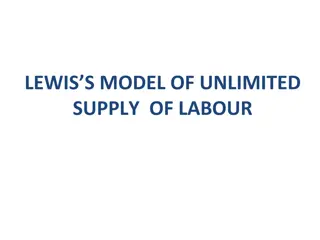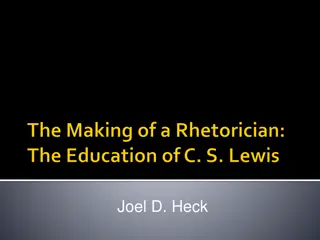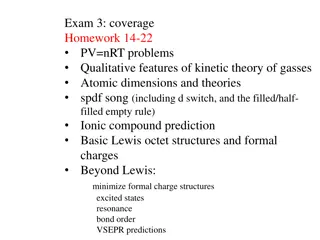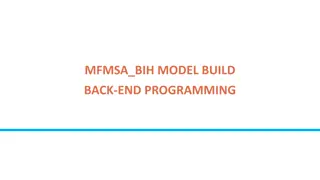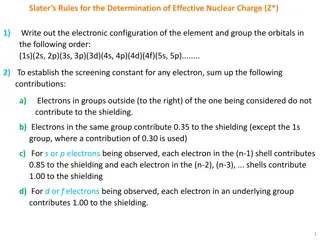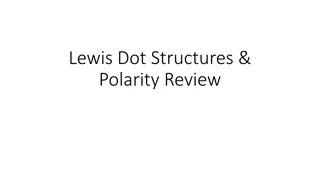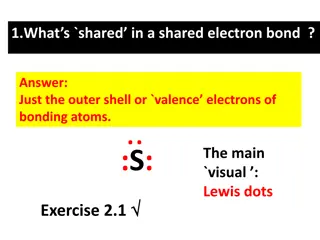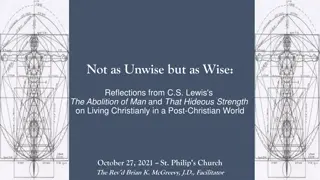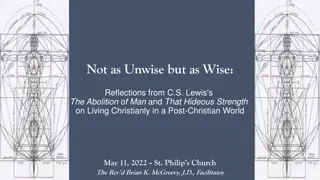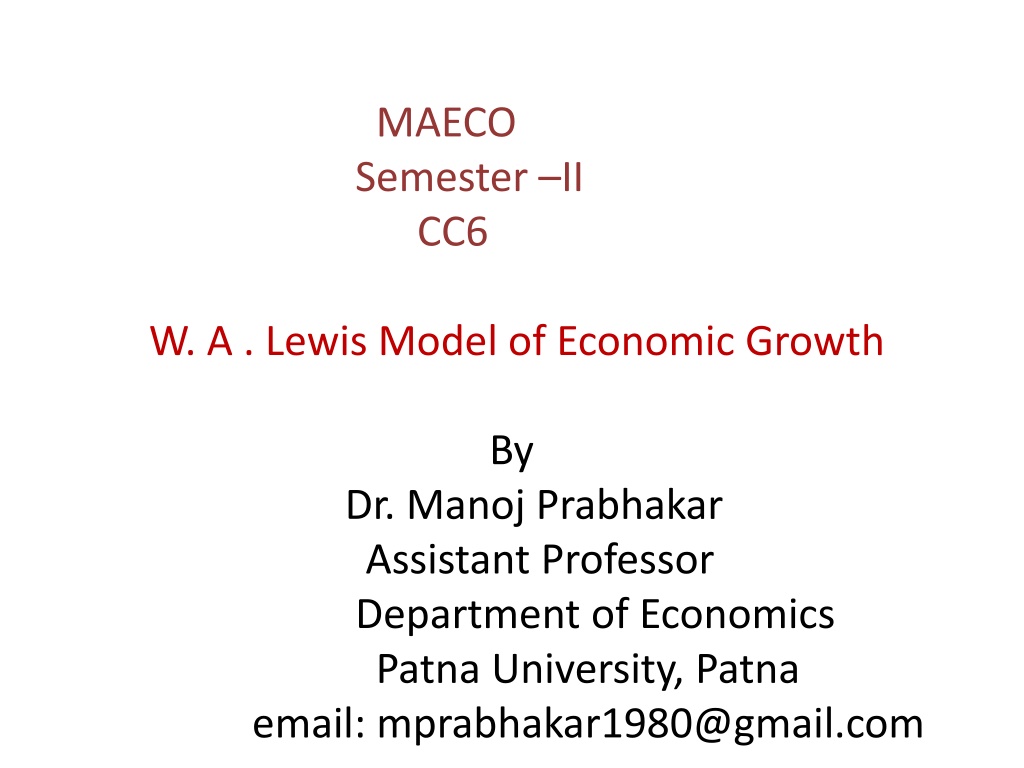
Understanding Lewis Model of Economic Growth
The Lewis Model of Economic Growth, developed by W. Arthur Lewis in the 1950s, focuses on the structural transformation of economies with surplus labor. This model emphasizes the transition of labor from a traditional subsistence sector to a modern capitalist sector, explaining the dynamics of output, employment, and capital accumulation. By analyzing the process of labor transfer and growth in the modern sector, the model sheds light on economic development in underdeveloped countries with abundant labor and limited capital.
Download Presentation

Please find below an Image/Link to download the presentation.
The content on the website is provided AS IS for your information and personal use only. It may not be sold, licensed, or shared on other websites without obtaining consent from the author. If you encounter any issues during the download, it is possible that the publisher has removed the file from their server.
You are allowed to download the files provided on this website for personal or commercial use, subject to the condition that they are used lawfully. All files are the property of their respective owners.
The content on the website is provided AS IS for your information and personal use only. It may not be sold, licensed, or shared on other websites without obtaining consent from the author.
E N D
Presentation Transcript
MAECO Semester II CC6 W. A . Lewis Model of Economic Growth By Dr. Manoj Prabhakar Assistant Professor Department of Economics Patna University, Patna email: mprabhakar1980@gmail.com
The early theorectical model of development that focussed on the structural transformation of a primarily subsistence economy was that formulated by Nobel laureate W. Arthur Lewis in the mid-1950s and latter modified , formalised and extended by John Fei and Gaustav Ranis. The Lewis two-sector model became the general theory of development process in surplus labour Third World nations during the most of the 1960s and early 1970s. It still has many adherents today.
This essay is written in the classical tradition, making the classical assumption and asking the classical question. The classics, from Smith to Marx, all assumed or argued that an unlimited supply of labour was available at subsistence wages. They then enquired how production grows through time. They found the answer in capital accumulation, which they explained in terms of their analysis of the distribution of income. Classical systems thus determined simultaneously income distribution and income growth, with the relative prices of commodities as a major by product.
The purpose of this essay Economic Development with Unlimited Supplies of Labour is to see what can be made of the classical framework in solving problems of distribution, accumulation and growth,first in closed and then in open economy. This two sector theory-subsistence sector and capitalist sector, has great analytical value. It explains how low capital formation takes place in underdeveloped countries which have abundance of labour and scarcity of capital. The problem of credit, inflation, population growth, technological progress and international trade gives the theory a touch of realism.
In the Lewis model, the underdeveloped economy consists of two sectors: i. A traditional, overpopulated rural subsistence sector characterised by zero marginal labour productivity a situation that permits Lewis to classify this as surplus labour in the sense that it can be withdrawn from traditional agriculture sector without any loss of output. ii. A high productivity modern urban industrial sector i.e. Capitalist sector into which labour from subsistence sector is gradually transferred.
The primary focus of the model is on both the process of labour transfer and the growth of output and employment in modern sector. Both labour transfer and modern-sector employment growth are brought about by ouput expasion in that sector. The speed with which this expansion occurs is determined by the rate of industrial investment and capital accumulation in the modern sector. Such investment is made possible by the excess of modern-sector profits over wages on the assumption that capitalists reinvest all their profits.
Finally, assumed that the level of wages in the urban industrial sector was constant, detrmined as a given premium over a fixed average subsistence level of wages in the traditional agriculture sector. At the constant urban wage, the supply curve of rural labour to the modern sector is considered to be perfectly elastic.
Growth Process: The process of modern-sector self-sustaining growth and employment expansion continue untill all surplus labour absorbed in the new industrial sector. In underdeveloped countries there exists large reservoirs of labour whose marginal productivity is almost zero or negative. It is available in unlimited quantities at a wage equal to the subsistence levels of living plus a margin sufficient to overcome the friction of moving from the Subsistence sector to the Capitalist sector which may be called Subsistence-plus wage.
The capitalist sector needs skilled workers. But Lewis maintains that skilled labour is only temporary bottleneck and can be removed by providing training facility to unskilled labours. Thereafter, additional workers can be withdrawn from the agricuture sector only at a higher cost of lost food production because the declining labour- to-land ratio means that the marginal product of rural labour is no longer zero .
Thus the labour supply curve becomes positively sloped as modern sector wages and employment continue to grow. The structural transfomation of the economy will have taken place, with the balance of economic activity shifting from traditional rural agriculture to modern urban industry. The development model can be explained with the help of a figure as:
M4 M3 M2 M1 Wage & Marginal Product W R1 R2 R3 R4 W S S O N1 Quantity of Labour N2 N3 N4 X
In the figure ,the quantity of labour employed measured on horizontal axis and the wage and marginal product on the vertical axis. OW represents the capitalist wage and OS represent average subsistence wage in the subsistence sector. At OW wage in the capitalist sector, the supply of labour is unlimited as shown by the horizontal supply curve of labour WW. In the starting phase, when ON1, labour is employed in the capitalist sector M1R1 is the marginal productivity curve and the total output of this sector is OM1R1N1. Out of this, the area OWR1N1 is paid as wage to the workers. The remaining area WR1M1 shows surplus output. This is capitalist surplus or total profit earned by the capitalist sector.
When this surplus is reinvested, the marginal productivity curve shifts upward to M2R2 The capitalist surplus and employment are now larger than before being WM2R2 and ON2 respectively. The marginal productivity curve rise due to reinvestment and the level of employment to M3R3 and ON3 and so on,till the entire surplus labour is absorbed in the capitalist sector. After this, the slope of the supply curve WW will be from left to right upwards like an ordinary supply curve. Wages and employment will continue to rise with development.
Criticism of the Lewis Model: Although the Lewis two sector development model is simple and roughly reflects the historical experience of economic growth in the West, some of its key assumptions do not fit the institutional and economic realities of most contemporary developing countries. The model implicitly assumes that the rate of labour transfer and employment creation in the capitalist sector is proportional to the rate of capitalist sector capital accumulation. The faster the rate of capital accumulation, the higher the growth of the modern sector and the faster the rate of new job creation.
But what if capitalist profits are reinvested in more sophisticated labour saving capital equipment rather than just duplicating the existing capital, as is implicicitly assumed in the Lewis model? An assumtion of the model is capitalist profits are in fact reinvested in the local economy and not sent abroad as a form of capital flight but if it happens then situation will be different. When we take into account the labour saving bias of modern technological transfer, the existence of substantial capital flight, the widespread nonexistence of rural surplus labour, the growing prevelence of urban surplus labour and the tendency for modern sector wages to rise rapidly
even where substantial open unemployment exists. We must acknowledge that the Lewis two sector model- though valuable as an early portrayal of the development process of sectoral interaction and structural change requires considerable modification in assumptions and analysis to fit the reality of contemporary developing nations.
Suggested Readings: Todaro, Michael P and Smith ,Stephen C. (2012): Economic Development, Pearson Education, Delhi Taneja, M.L and Mayer, R.M.(2013): Economics of Development & Planning, Vishal Publishing Co. Jalandhar Singh, S.P (2007): Arthik Vikas aur Niyojan, S.Chand, New Delhi Mishra,S.K. and Puri, V.K.(2012): Economics of Development and Planning, Himalya Publishing House, New Delhi.


